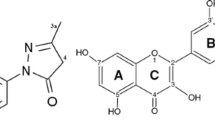Abstract
Flavonoid antioxidants act as scavengers of free radicals by rapid donation of a hydrogen atom. This quantitative structure–activity relationship (QSAR) study of flavones was carried by using selected quantum chemical descriptors. PM3 calculations performed by MOPAC 2000 associated with Cache pro. Molecular weight, dielectric energy (kcal/mole), total energy (Hartree), heat of formation (kcal/mole), highest unoccupied molecular orbital (HOMO) energy (eV), lowest unoccupied molecular orbital (LUMO) energy (eV), log P, molar refractivity (MR), hardness (η), softness (S), chemical potential (μ), electrophilicity index (ω), etc. were tested as descriptors, and various QSAR models were constructed. The best-fit model ( \( r^{{\text{2}}}_{{{\text{CV}}}} = 0.92,r^{2} = 0.96 \)) involved heat of formation, log P, MR, and molecular weight. The overall study indicates that steric bulk and solvation are mainly responsible for the radical scavenging activity of flavones.


Similar content being viewed by others
References
Bors W, Heller W, Michel C, Saran M (1990) Flavonoids as antioxidants: determination of radical-scavenging efficiencies. Methods Enzymol 186:343–55
Burda S, Oleszek W (2001) Antioxidant and antiradical activities of flavonoids. J Agric Food Chem 49(6):2774–2779
Chen ZY, Chan PT, Ho KY, Fung KP, Wang J (1996) Antioxidant activity of natural flavonoids is governed by number and location of their aromatic hydroxyl groups. Chem Phys Lipids 79(2):157–63
Clare BW (1995) Structure-activity correlations for psychotomimetics 3. Tryptamines. Austral J Chem 48(8):1385–1400
Ghose AK, Pritchett A, Crippen GM (1988) atomic physicochemical parameters for 3-dimensional structure directed quantitative structure-activity relationships 3. Modeling hydrophobic interactions. J Comput Chem 9(1):80–90
Iczkowski R, Margrave JL (1961) Electronegativity. J Am Chem Soc 83(17):3547–3551
Karelson M, Lobanov VS, Katritzky AR (1996) Quantum-chemical descriptors in QSAR/QSPR studies. Chem Rev 96(3):1027–1044
Koopmans TC (1934) Ueber die Zuordaung von Wellenfunktionen und Eigenwerten zu den einzelnen Elektronen eines Atoms. Physica 1(2):104–113
Leo A, Hansch C, Elkins D (1971) Partition coefficients and their uses. Chem Rev 71(6):525-+
Padmanabhan J, Parthasarathi R, Subramanian V, Chattaraj PK (2007a) Electrophilicity-based charge transfer descriptor. J Phys Chem A 111(7):1358–1361
Padmanabhan J, Parthasarathi R, Subramanian V, Chattaraj PK (2007b) Philicity based site activation model towards understanding the Markovnikov regioselectivity rule. J Molec Struct Theochem 804(1–3):17–20
Parr RG, Pearson RG (1983) Absolute hardness — companion parameter to absolute electronegativity. J Am Chem Soc 105(26):7512–7516
Parr RG, Von Szentpaly L, Liu SB (1999) Electrophilicity index. J Am Chem Soc 121(9):1922–1924
Parr RG, Yang WT (1995) Density-functional theory of the electronic-structure of molecules. Annu Rev Phys Chem 46:701–728
Parr RG, Yang WT (1984) Density functional-approach to the frontier-electron theory of chemical-reactivity. J Am Chem Soc 106(14):4049–4050
Parthasarathi R, Subramanian V, Roy DR, Chattaraj PK (2004) Electrophillicity index as a possible descriptor of biological activity. Bioorganic & Medicinal Chemistry 12(21):5533–5543
Pasha FA, Chung HW, Cho SJ, Kang SB (in press), 3D-quantitative structure activity analysis and quantum chemical analysis of pyrido-di-indoles. International Journal of Quantum Chemistry
Pasha FA, Srivastava HK, Singh PP (2005a) Comparative QSAR study of phenol derivatives with the help of density functional theory. Bioorg Med Chem 13(24):6823–6829
Pasha FA, Srivastava HK, Singh PP (2005b) QSAR study of estrogens with the help of PM3-based descriptors. Int J Quant Chem 104(1):87–100
Pasha FA, Srivastava HK, Srivastava A, Singh PP (2007) QSTR study of small organic molecules against Tetrahymena pyriformis. QSAR Combin Sci 26(1):69–84
Pietta PG (2000) Flavonoids as antioxidants. J Nat Prod 63(7):1035–42
Rice-Evans CA, Miller NJ, Paganga G (1996) Structure-antioxidant activity relationships of flavonoids and phenolic acids. Free Radic Biol Med 20(7):933–56
Sanderson RT (1955) Partial charges on atoms in organic compounds. Science 121(3137):207–208
Sichel G, Corsaro C, Scalia M, Di Bilio AJ, Bonomo RP (1991) In vitro scavenger activity of some flavonoids and melanins against O2-(.). Free Radic Biol Med 11(1):1–8
Singh PP, Srivastava HK, Pasha FA (2004) DFT-based QSAR study of testosterone and its derivatives. Bioorg Med Chem 12(1):171–177
Smeyers YG, Bouniam L, Smeyers NJ, Ezzamarty A, Hernandez-Laguna A, Sainz-Diaz CI (1998) Quantum mechanical and QSAR study of some alpha-arylpropionic acids as anti-inflammatory agents. Eur J Med Chem 33(2):103–112
Srivastava HK, Pasha FA, Singh PP (2005) Atomic softness-based QSAR study of testosterone. Int J Quant Chem 103(3):237–245
Stewart JJP (1989a) Optimization of parameters for semiempirical methods 1. Method. J Comput Chem 10(2):209–220
Stewart JJP (1989b) Optimization of parameters for semiempirical methods 2. Applications. J Comput Chem 10(2):221–264
van Acker SA, van den Berg DJ, Tromp MN, Griffioen DH, van Bennekom WP, van der Vijgh WJ, Bast A (1996) Structural aspects of antioxidant activity of flavonoids. Free Radic Biol Med 20(3):331–42
Viswanadhan VN, Ghose AK, Revankar GR, Robins RK (1989) atomic physicochemical parameters for 3 dimensional structure directed quantitative structure–activity relationships 4. additional parameters for hydrophobic and dispersive interactions and their application for an automated superposition of certain naturally-occurring nucleoside antibiotics. J Chem Inform Comput Sci 29(3):163–172
Acknowledgment
This study was supported by the KIST Linux super computer.
Author information
Authors and Affiliations
Corresponding author
Rights and permissions
About this article
Cite this article
Pasha, F.A., Cho, S.J., Beg, Y. et al. Quantum chemical QSAR study of flavones and their radical-scavenging activity. Med Chem Res 16, 408–417 (2007). https://doi.org/10.1007/s00044-007-9060-5
Received:
Accepted:
Published:
Issue Date:
DOI: https://doi.org/10.1007/s00044-007-9060-5




